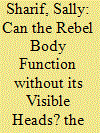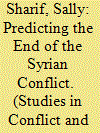| Srl | Item |
| 1 |
ID:
190150


|
|
|
|
|
| Summary/Abstract |
Mid-level commanders are commonly considered the visible heads of the rebel body: as leaders of combat operations, they are often targeted in counterterrorism or counterinsurgency operations. While their role during conflict has been theorized extensively, only recent scholarship has focused on mid-level commanders in post-conflict transitions. Specifically, it is not clear how mid-level commanders function within ex-combatant groups to create divergent peacebuilding results. This paper argues that transitions from conflict involve fraying of wartime bonds and rebel command-and-control structures, which is counterproductive to peace when rebels demobilize collectively. In peacetime and in the absence of wartime command, social groups formed through military logic struggle to redefine individual roles. Mid-level commanders, responsible for shaping intergroup bonds during conflict, are essential for allocating ex-combatant roles and redefining rebel-civilian relations. Against the common practice of breaking rebel wartime command-and-control structure during demobilization, this paper argues that ex-combatant groups can demobilize and reintegrate more successfully if they maintain their wartime cohesion and are provided the necessary tools for building sustainable livelihoods. To support the argument, the paper provides original qualitative and quantitative evidence from the Disarmament, Demobilization, and Reintegration (DDR) programme with the Revolutionary Armed Forces of Colombia (FARC).
|
|
|
|
|
|
|
|
|
|
|
|
|
|
|
|
| 2 |
ID:
178667


|
|
|
|
|
| Summary/Abstract |
The Syrian civil war has confounded all predictions on its end date and is still ongoing. Valuable explicative work has been done on civil war duration; however, scholars have failed to reliably predict the end of ongoing conflicts. This article argues that faulty predictions on termination date of the Syrian conflict did not necessarily result from statistical errors in modeling civil wars data and better models might not necessarily mitigate the prediction problem. Rather, three factors contributed to the misperceptions: the conflict’s cartography problem, the splintering of the opposition, and the multi-partner foreign intervention in the conflict. The last two factors can also be held accountable for prolonging the conflict. Incorrect predictions or descriptions in scholarly works on ongoing conflicts can have disastrous implications for the present and future of states and populations beset by protracted conflict. Had it been made clear that neither the insurgents nor the government had the capacity to win the war within the predicted timeframe, the international community may have taken a more decisive role in bringing belligerents to the negotiation table, improving prospects for a peaceful diplomatic settlement.
|
|
|
|
|
|
|
|
|
|
|
|
|
|
|
|